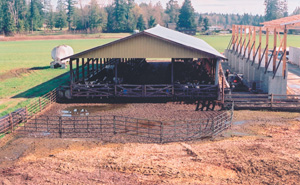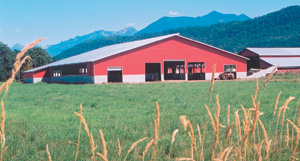
There are a number of existing
beneficial management practices livestock producers can now use to
potentially reduce manure odor, and many more are currently being
researched to evaluate their effectiveness.
 |
There are a number of existing beneficial management practices livestock producers can now use to potentially reduce manure odor, and many more are currently being researched to evaluate their effectiveness.
For most operations, improving odor management requires a combination of several strategies because livestock odor is influenced by many factors, which include:
- adjusting animal diets;
- considering the site and facility operations;
- options for manure storage and treatment;
- applying manure to land.
This factsheet deals with what options producers can consider for reducing odor when choosing a site, designing livestock facilities and/or storing and treating manure at those facilities.
Site and Facility Considerations for Managing Odor
There are a number of beneficial management practices livestock producers can use that may reduce odor (Table 1).
 Table 1. Siting and building options for potentially reducing odor. Table 1. Siting and building options for potentially reducing odor. |
Furthermore, a number of researchers worldwide are developing and testing many promising technologies for reducing odor. These include the use of oil sprinkling, biofilters, additives and composting (Table 2).
Table 2. Possible technologies for odor reduction from livestock facilities. |
There is a number of existing beneficial management practices livestock producers can use now to potentially reduce odor.
Options for Manure Storage and Treatment
Manure storage and treatment methods can all impact odor levels and are affected by the type of manure system being used. Table 3 outlines strategies that may reduce odor for wet and solid manure systems.
Table 3. Possible approaches to reducing odor during storage of manure. |
Action on Odor
Private and public researchers in North America and Europe are investigating many potential approaches to reduce manure odor, such as electrical and electrochemical processes, ozonation, ultrasound, a membrane filtration system that can handle thick slurries, and resonant shock waves.
 |
Research is underway to measure manure quality and odor emissions from livestock operations. It will compare manure treated with various composting methods and raw manure. This research is part of an industry/government odor control initiative to minimize odor emissions from livestock operations.
This factsheet is part of a series on odor and odor reduction for livestock operations from Alberta Agriculture, Food and Rural Development. Copies of the other factsheets in this series and more information on odor is available at the AAFRD web site at www.agric.gov.ab.ca.